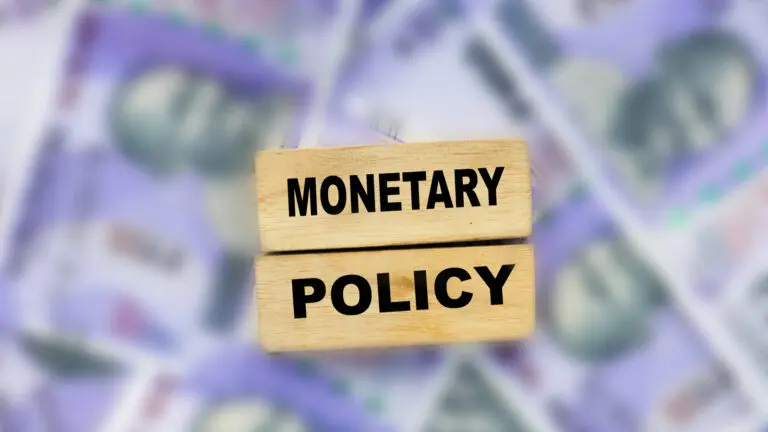
Credit Growth improves.
The keenly watched banking credit growth rebounded in the latest data release. For the fortnight ended 11 July 2025, aggregate banking credit improved to 9.8%. This is up from the 9% credit growth witnessed at the end of May (before RBI’s jumbo 50bps rate cut). This marks the strongest increase since early May and indicates RBI’s rate cut may be having its desired impact.
The week also saw India’s forex reserves moderating again to ~ USD 695bn. This brings the total decrease in forex reserves in July to USD 7bn.
Improving credit growth – highest since early May:
Credit growth seems to be on an improving trend. The latest data from RBI shows that India’s banking credit has inched up and is above 9.8%. This is the highest level since May and likely indicates RBI’s policy rate cuts taking effect.
Before the current release, credit growth had moderated and raised concerns over whether the RBI’s jumbo 50bps rate cut was enough. After a brief improvement immediately following the rate cut, credit growth had moderated.
The jumbo rate cut by the RBI was partially driven by the sharp fall in credit growth from above 10% to below 9% as of the end of May. This was the worst credit growth witnessed in three years. The sharp fall happened despite the RBI’s start of the rate-cut cycle in 2025. RBI cut repo rate already by 50bps in 2025 (prior to the 50bps rate cut in June). Anaemic demand for credit, coupled with a lack of speedy transmission of rate cuts, was the likely culprit.
A quick recap of India’s credit growth is that the conditions were excessively “hot” last year. During 2024, banking credit had jumped 20% on a year-on-year basis, supported by strong demand from corporates, retail borrowers, as well as from the services sector. The high pace was unsustainable and carried risks of asset quality deterioration and overheating in pockets of the economy.
A slowdown in both retail and corporate credit has resulted in the current slowdown. A variety of factors, including tighter norms for NBFC credit and unsecured retail credit (credit cards, personal loans, etc.) are being attributed to this. While a moderation was expected, the sharp fall is increasingly a cause for worry.
Figure: Credit Growth moderated after showing initial signs of recovery
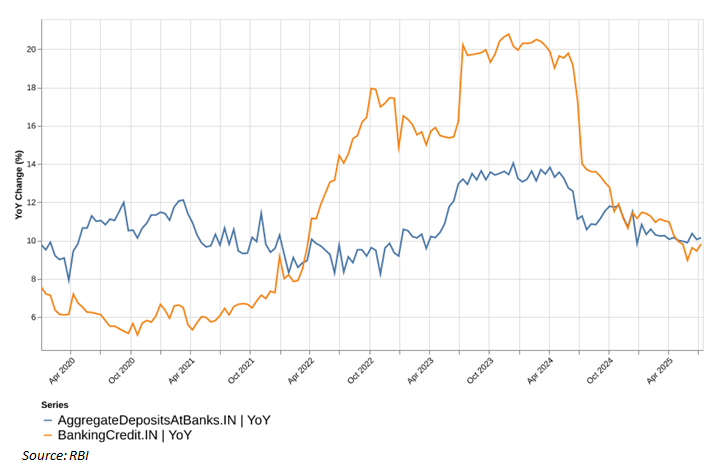
SDF utilisation falls further:
SDF utilisation dropped again. Since April, Indian banks have shown a sharp inclination to park excess funds in SDF. This had led to SDF balances (20D rolling average) increasing to their highest levels in 3 years. However, the latest data shows signs of moderation. After spiking to more than INR 2.5 trn, they have moderated sharply. From a daily peak of more than INR 3 trn in early July, they have fallen to less than INR 1trn. This moderation also coincides with the pickup in credit growth.
Figure: SDF utilisation has started to moderate
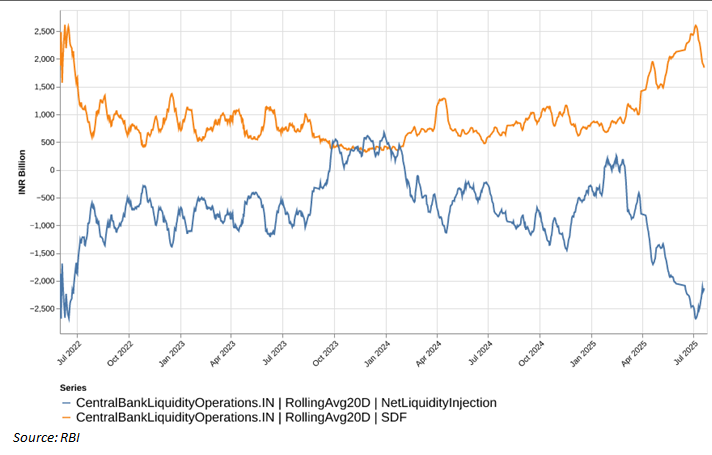
What is SDF – A Primer
The SDF is a non-collateralised instrument which banks can use for parking their surplus funds at the RBI and earn interest at a slightly lower rate than the repo. It was implemented in April 2022 as a cleaner and more efficient alternative to the conventional reverse repo.
Unlike reverse repo, the SDF does not mandate the RBI to transfer government securities as collateral, making it a more efficient tool to absorb liquidity. This has now become the de facto floor of the RBI’s LAF corridor.
Credit Deposit Ratio – Spikes:
As per the latest data release, the credit deposit ratio has reversed its trend and spiked. The pickup in recent credit growth is the likely reason. After moderating to ~77.5%, it has spiked to 79% as per the latest data release. This is among the highest credit deposit ratios seen in the past 3 years.
Figure: Credit Deposit Ratio Spikes
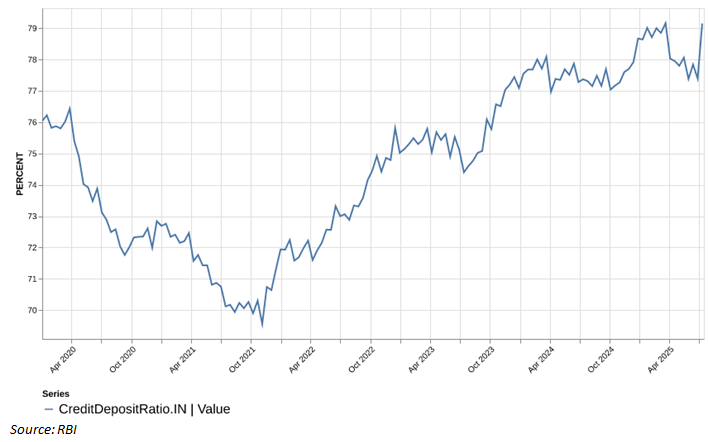
Forex Reserves fell another ~USD 1.2 bn:
A week after crossing USD 700 bn in end-June, India’s forex reserves fell in July. Last week, they fell USD1.2bn to end at USD 695.5 bn. The decrease was almost entirely due to a sharp decrease in foreign currency assets. The total value of foreign currency assets decreased by USD 1.3 bn to USD 587.6 bn. Gold reserves increased modestly to USD 84.5 bn. Gold reserves had increased substantially YTD. In 2025, while gold accounted for only 12% of total reserves, it contributed to 25% of incremental reserves.
Figure: Forex reserves fell modestly
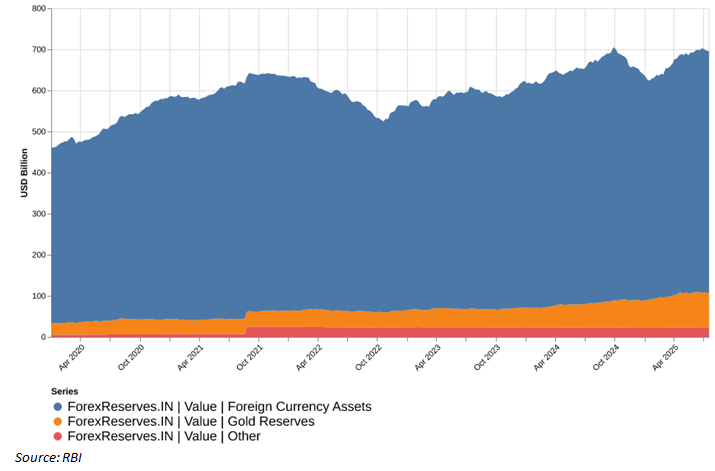
RBI’s repo rate history:
After having maintained the benchmark policy interest rate (repo rate) for more than a year, the Reserve Bank of India (RBI) had cut the benchmark rates by 100bps in 2025. The last cut of 50bps had come as a positive surprise vs the expectation of 25bps. The cut was also significant as it took the repo rate to levels not seen since 2022.
While the rate cuts had been surprising, there was also a notable change in stance in the RBI’s monetary policy. It changed from ‘Accommodative’ to ‘Neutral’. In essence, this implied that further rate cuts were unlikely unless the growth surprises negatively.
The latest banking credit growth data also showed that the RBI’s monetary easing may already be impacting credit growth positively. Banking credit improved to 9.8%.
Figure: 100bps Repo Rate in 2025

What is Repo Rate – A Primer
The repo rate is the rate at which the RBI lends to commercial banks. A lower rate of interest reduces the cost of borrowing for banks and can ultimately mean lower interest rates for loans to consumers and businesses. It is the primary device employed by the RBI to manage the economic activity in the country.
Goals behind a cut in the Repo Rate
Encouraging Credit Demand: By making borrowing cheaper, it encourages households and firms to borrow and spend on consumption and investment goods. That can be particularly good for rate-sensitive areas like housing, auto and small business.
Boosting the Economy: Economists say the Reserve Bank of India’s cut will help lift economic activity by bringing down the cost of spending and investment.
Inflation Management: The RBI’s move to reduce the repo rate comes against the backdrop of inflation moderating, particularly in food prices. Retail inflation dropped, giving the central bank room to have a more accommodative stance without actually contravening its inflation targets.
Boost Liquidity: The rate reduction is combined with steps to provide liquidity to the banking system, so banks have the required cash to lend more money.
Related Tags

![]() IIFL Customer Care Number
IIFL Customer Care Number
(Gold/NCD/NBFC/Insurance/NPS)
1860-267-3000 / 7039-050-000
![]() IIFL Capital Services Support WhatsApp Number
IIFL Capital Services Support WhatsApp Number
+91 9892691696
IIFL Capital Services Limited - Stock Broker SEBI Regn. No: INZ000164132, PMS SEBI Regn. No: INP000002213,IA SEBI Regn. No: INA000000623, SEBI RA Regn. No: INH000000248, DP SEBI Reg. No. IN-DP-185-2016, BSE Enlistment Number (RA): 5016
ARN NO : 47791 (AMFI Registered Mutual Fund Distributor), PFRDA Reg. No. PoP 20092018

This Certificate Demonstrates That IIFL As An Organization Has Defined And Put In Place Best-Practice Information Security Processes.